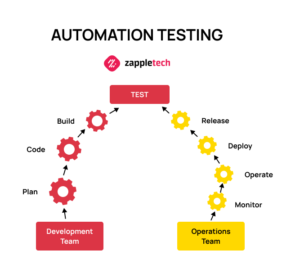Creating a robust test automation maintenance strategy is essential for ensuring the longevity and effectiveness of your test automation efforts. As organizations increasingly rely on automated testing to streamline their quality assurance processes, it becomes crucial to have a plan in place that keeps these systems running smoothly. A well-crafted test automation maintenance strategy not only helps in identifying and fixing issues promptly but also ensures that the automated tests remain relevant and up-to-date as the application evolves.
Test automation maintenance is a continuous process that involves regular updates, refactoring, and optimization of test scripts to align with changes in the application. By implementing a comprehensive test automation strategy, teams can reduce the risk of test failures, minimize downtime, and maintain high levels of test accuracy. This article will guide you through the key steps and best practices for developing an effective test automation maintenance strategy, enabling your team to achieve long-term success in your automation efforts.
Automated Testing (AT) is not just a replacement for manual work or another way to reduce IT project costs. It is a helpful tool for managing product quality and taking QA to a new level. You can run more tests in a limited time, which allows you to quickly find bugs in your system and make decisions about fixing them. However, do not forget about the need for test automation maintenance. With the wrong strategy, it can slow down your product’s time to market. Let’s consider how to optimize the maintenance.

Table of Contents
Test automation maintenance — what is it?
Test automation maintenance refers to one of the most crucial phases in the testing lifecycle. As systems undergo regular changes, functionalities are consistently updated and improved. The primary purpose of maintenance is to check the stability and correctness of implemented functions and plan future steps to ensure the system’s reliability.
This concept is equally important in automated testing. Maintenance becomes necessary when new scripts are added, requiring thorough testing and support. These activities are vital at the project-wide level, enhancing the efficiency of test scenarios as the process evolves at each stage of the Automated Testing Life Cycle (ATLC).
Challenges in Test Automation Maintenance
Often, automation testing specialists face significant challenges in test automation maintenance. This phase is labor-intensive and time-consuming, yet indispensable. Without proper maintenance, automated tests can become ineffective, slowing down project development and increasing costs. Therefore, it is crucial to plan ahead and develop a robust test automation strategy to ensure the process remains smooth and efficient.
By incorporating a well-defined test automation strategy, teams can address these challenges effectively. This strategy should include regular updates and reviews of test scripts, ensuring they remain relevant and efficient. It also involves continuous monitoring of test results to identify and resolve issues promptly.
In conclusion, test automation maintenance is a critical aspect of the testing lifecycle. By understanding its importance and implementing a solid test automation strategy, teams can enhance the efficiency and reliability of their automated testing processes.

How to choose a test automation maintenance approach?
Choosing the right test automation maintenance approach is critical to ensuring the effectiveness and efficiency of your automated testing process. Problems often arise from the wrong choice of tests. For example, it makes little sense to automate testing for features that are in beta testing or for one-off tests. Implementing automation tools in these scenarios can take longer than manual testing and may not provide significant benefits.
Additionally, while working on a project, automation testing (AT) specialists may encounter changes in requirements or clarifications from developers, including internal refactoring that may alter the class interface. These changes invariably impact the criteria and conditions for the acceptance of functions and tests. Therefore, having a robust test automation strategy in place is essential to adapt to these changes smoothly.
Here are some ways to form an effective test automation maintenance approach:
Prioritize Tests for Automation: Focus on automating tests that are stable and repeatable. Avoid automating tests for features still in flux or those that are rarely executed. This prioritization helps in reducing maintenance efforts and ensures that your automation suite remains relevant and efficient.
Develop a Robust Test Automation Strategy: A well-defined strategy helps in managing changes and scaling your test automation efforts. This strategy should include guidelines for selecting test cases for automation, defining the scope of automation, and setting up a process for regular review and update of test scripts.
Regularly Update Test Scripts: As the system evolves, test scripts need to be updated to reflect changes in the application. Regular maintenance and updates ensure that your automated tests remain effective and do not become obsolete.
Use Version Control: Implementing version control for your test scripts allows you to track changes, revert to previous versions if necessary, and collaborate effectively with other team members.
Continuous Monitoring and Reporting: Implement continuous monitoring of your test automation suite to identify issues promptly. Regular reporting helps in keeping track of the health of your automated tests and ensures that any problems are addressed swiftly.
Incorporate Feedback Loops: Establish feedback loops between developers and testers to ensure that any changes in the application are promptly communicated and incorporated into the test automation suite.
By following these approaches, you can avoid problems associated with adding new functions, scaling the project, and making changes to it. A well-planned test automation maintenance approach not only improves the stability and correctness of your tests but also enhances the overall efficiency of your development process.
5 components of a good maintenance strategy:
1. Establishing connections with UI/UX
Maintaining an IT project involves close cooperation with specialists of different profiles, particularly those working on the user interface (UI) and user experience (UX). Developers who handle the interface play a significant role in the project, as changes are often made to the user interface to make it more convenient, relevant, and understandable. However, these changes can impact the test suite, making test automation maintenance a critical consideration.
Focusing on the location coordinates of an interface object, HTML map, or dynamic identifier can make your tests overly sensitive to changes in the interface. This sensitivity often leads to frequent test failures whenever minor UI adjustments are made, increasing maintenance efforts. To mitigate this issue, forming a static naming convention is essential. This approach helps maintain the stability of your test automation suite amidst ongoing UI changes.
Here are several strategies to enhance test automation maintenance in the context of UI/UX changes:
Implement Static Naming Conventions: Using static identifiers, such as a static QA id in your code, reduces the impact of design changes on test suites. This practice is similar to how programmers ensure their code is easily transferable and understandable. Static naming conventions make it easier for automated tests to locate and interact with UI elements consistently, even as the UI evolves.
Collaboration with UI/UX Teams: Establishing strong communication channels between QA and UI/UX teams is vital. Regular updates and meetings ensure that testers are aware of upcoming changes, allowing them to adjust test scripts proactively. This collaborative approach is a key component of a robust test automation strategy.
Use of Page Object Model (POM): The Page Object Model is a design pattern that enhances test automation maintenance by separating the test logic from the UI representation. By creating an object repository for UI elements, POM allows changes to be made in one place, reducing the maintenance effort when UI changes occur.
Focus on creating simple, modular test cases that are easy to update and maintain. This approach reduces the complexity and makes it easier to manage changes as your application evolves.Mykhailo PoliarushCEO, ZappleTech Inc.
Automate Visual Testing: Incorporating visual testing tools can help ensure that the UI looks and functions as expected. These tools can detect visual discrepancies that might not be caught by traditional automated tests, providing an additional layer of verification.
Dynamic Locators with AI Assistance: Leveraging AI to create dynamic locators can help in maintaining tests even when the UI changes. AI-driven locators adapt to UI changes by understanding the context and relationships between elements, reducing the fragility of tests.
Regularly Review and Update Test Scripts: Continuous review and updating of test scripts ensure that they remain relevant and effective. This practice is crucial in maintaining a robust test automation strategy, particularly when dealing with frequent UI/UX changes.
2. Simplicity is paramount
As mentioned before, the efficiency of test automation largely depends on the time spent on maintenance. One way to expedite this process is by keeping test cases simple. Low-level tests are particularly suitable for this purpose, as they execute quickly and typically do not present technical support issues. For instance, unit tests do not require extensive automation costs and can be executed extremely fast, contributing significantly to an effective test automation strategy.
Modular Structure in Test Automation
Using a modular structure is highly beneficial when it is necessary to remove the dependency of one test on another. This approach positively impacts the quality of service, as it allows activities to be performed simultaneously or distributed across different teams. Additionally, reusable modules can save time and resources, making the overall process more efficient.
However, what if you need to work with complex and lengthy scripts? In such cases, it makes sense to implement test suites that can be used repeatedly. These suites should be designed to handle comprehensive scenarios while maintaining simplicity and clarity. This practice not only improves test automation maintenance but also enhances the robustness of the test automation strategy.
Managing Complex Test Cases
When dealing with complex test cases, it is crucial to pay attention to their design. Complicated test cases increase the time spent on support and the probability of failure. If you encounter a test case with many steps, it’s best to split it into two or more simpler cases. Each test case should ideally work with only one function or action. High complexity almost always leads to stability problems, making maintenance more challenging.
Strategies for Simplifying Test Automation
Focus on Low-Level Tests: Prioritize low-level tests such as unit tests, which are fast and cost-effective. These tests provide a solid foundation for your automation suite and are easier to maintain.
Adopt a Modular Approach: Design your test automation framework using a modular approach. This structure reduces dependencies and allows for easier updates and maintenance. Reusing modules can also streamline the testing process.
Implement Reusable Test Suites: For complex scripts, create reusable test suites that can handle multiple scenarios. These suites should be designed to maintain simplicity and effectiveness, facilitating easier maintenance.
Simplify Test Cases: Break down complex test cases into simpler ones. Each test case should focus on a single function or action, reducing the likelihood of stability issues and simplifying maintenance.
Use Static Naming Conventions: As previously mentioned, implementing static naming conventions, such as static QA ids, can help reduce the impact of UI changes on test suites, ensuring more stable and reliable tests.
Continuous Review and Optimization: Regularly review and optimize your test scripts to ensure they remain relevant and effective. This practice is essential for maintaining a robust test automation strategy and minimizing maintenance efforts.
3. A smart plan of action
In the fast-paced world of software development, there is often an urgent need to speed up releases. For example, imagine needing to check about 400 cases in a development sprint. Conducting a manual check for this volume of tests would take at least two weeks, significantly affecting overall productivity. In contrast, automated testing can complete the same task in just four hours, showcasing the immense time-saving benefits of a robust test automation strategy.
However, achieving this efficiency isn’t as simple as it might seem. Effective test automation requires a sensible and well-planned approach. Here’s how a smart plan of action can be implemented for effective test automation maintenance and strategy:
Prioritize Critical Tests: Identify and prioritize the most critical tests that need to be automated. Focus on areas that have the highest impact on the application’s functionality and user experience. By automating high-priority tests first, you ensure that the most crucial parts of your application are always tested efficiently.
Leverage Nightly Test Runs: Utilize the time when resources are least utilized by scheduling automated tests to run at night. This approach ensures that regular tests, such as those conducted when deploying new code, do not interfere with the productivity of your development team during the day. The results obtained from these night runs can be used for a detailed analysis of problems and for maintaining autotests.
Allocate Time for Maintenance: While automation saves time, it’s crucial to allocate dedicated time for test automation maintenance. Regularly updating and maintaining your test scripts ensures they remain effective and reliable. This practice helps in identifying and fixing issues promptly, thereby reducing the chances of test failures.
Integrate Continuous Testing: Incorporate continuous testing into your development pipeline. This strategy involves running automated tests continuously as part of the CI/CD process. It helps in detecting issues early and ensures that any changes made to the code are immediately verified by automated tests.
Balance Automation with Manual Testing: While automation significantly speeds up the testing process, it’s essential to balance it with manual testing for areas that require human judgment and intuition. This balanced approach ensures comprehensive test coverage and enhances the overall quality of the application.
Analyze Test Results Effectively: Effective analysis of test results is crucial for identifying trends and recurring issues. Use advanced reporting tools to gain insights into the test results, which can guide future test automation maintenance efforts. Detailed analysis helps in understanding the root cause of issues and in making informed decisions about necessary improvements.
Adopt a Modular Framework: Implement a modular test automation framework that allows for easy updates and maintenance. This approach reduces the time and effort required to modify tests when the application changes. It also promotes reusability of test components, making the overall process more efficient.
Invest in Training and Tools: Equip your team with the necessary training and tools to effectively manage test automation. Investing in the right tools and ensuring that your team is well-versed in best practices can significantly enhance the efficiency of your test automation strategy.
4. Focus on relevance
Maintaining the relevance of tests is crucial, especially when working on a large-scale and long-term project where functionality is constantly expanding and the user experience is continuously improving. Tests must be executed considering all changes and new requirements to ensure they remain effective and provide accurate results.
Strategies for Ensuring Test Relevance
Regular Review and Updates: Regularly reviewing and updating your test scripts is vital to ensure they stay aligned with the latest changes in the application. This practice is a cornerstone of an effective test automation strategy. By continuously assessing and modifying tests, you can prevent outdated scripts from causing test failures and ensure they reflect the current state of the application.
Clear Understanding of Deadlines and Goals: To keep pace with changes, it is essential to have a clear understanding of project deadlines and the methods needed to achieve goals quickly. Establishing a timeline for test updates and setting milestones can help manage the maintenance process efficiently. This proactive approach ensures that test automation maintenance is not a reactive task but an integral part of the development process.
Regularly review and update your test scripts to ensure they remain relevant and effective. Implement a system for continuous updates and allocate dedicated time for maintenance to keep your tests aligned with the latest changes in your application.Mikhail BodnarchukCDO, ZappleTech Inc.
Implement a Script Update System: Installing a script update system can automate the process of updating test scripts, making it easier to keep them current. This system can track changes in the application and automatically adjust the test scripts accordingly. By reducing manual effort, this approach enhances the efficiency of test automation maintenance.
Monitor Data Relevance: Data processing is one of the most challenging aspects for automation testing specialists. Frequent changes in data can lead to script failures. To prevent this, it is crucial to update the database and its status regularly. Alternatively, creating a new data set each time you run the scripts can ensure that tests always use the most relevant data, minimizing the risk of failures.
Additional Considerations for Maintaining Relevance
Integrate Continuous Feedback Loops: Establish continuous feedback loops between developers, testers, and other stakeholders. Regular communication ensures that everyone is aware of the latest changes and requirements, allowing test scripts to be updated promptly.
Utilize Automated Tools for Monitoring: Employ automated tools that can monitor the relevance of tests and data. These tools can provide real-time insights into the status of your test automation suite, highlighting areas that require updates or modifications.
Prioritize High-Impact Areas: Focus your maintenance efforts on high-impact areas of the application. By prioritizing tests that cover critical functionalities and user experiences, you can ensure that the most important aspects of your application are always tested thoroughly and accurately.
Adopt a Modular Testing Framework: A modular testing framework allows for easier updates and maintenance. By breaking down tests into smaller, reusable components, you can quickly update individual modules without affecting the entire test suite. This approach enhances the flexibility and scalability of your test automation strategy.
5. No instability
When performing test automation and its technical maintenance, ensuring stability is paramount. However, achieving this stability can be challenging due to failed tests with conflicting and floating results. These inconsistent outcomes, based on the same parameters but yielding ambiguous data, can significantly increase development time and create problems for testers.
Identifying the Root Causes of Instability
Understanding the root causes of instability is crucial for effective test automation maintenance. Often, instability arises from issues in the test configuration or the development code itself. Here’s how to diagnose and address these issues:
Repeat Failed Tests: When a test fails, repeat it to determine if the failure is consistent. Multiple setbacks usually indicate programming errors. On the other hand, successful outcomes or floating outcomes point to instability in the test environment or setup.
Analyze Test Data: Tests can be unstable due to the selection of incorrect or inconsistent data. Ensuring that your test data is accurate, relevant, and consistent is essential for reliable test results. Regularly update and validate your data sets to avoid issues caused by outdated or incorrect data.
Correct Initialization and Cleanup Processes: Incorrect initialization or cleanup procedures can lead to unstable tests. Ensure that each test starts with a clean state and that any necessary setup steps are correctly performed. Proper cleanup after each test is also crucial to prevent interference between tests.
Manage Dependencies: Tests that depend on the order of execution can lead to instability. Adopting a modular and independent test structure helps in minimizing these dependencies. Each test should be able to run in isolation without relying on the outcomes or state of other tests.
Handle Asynchronous Actions: Asynchronous actions can cause timing issues, leading to test instability. Implementing appropriate wait times and synchronization methods can help in managing these asynchronous actions effectively. Tools that provide robust handling of asynchronous operations can further enhance test stability.
Strategies to Ensure Stability
Automated Monitoring and Alerts: Utilize automated monitoring tools to track the stability of your tests. These tools can provide real-time alerts and insights into test performance, helping you quickly identify and address any issues.
Regular Code Reviews and Audits: Conduct regular code reviews and audits to ensure that both the test scripts and the application code adhere to best practices. Identifying and resolving potential issues early in the development process can prevent instability in your test automation strategy.
Robust Test Environment: Maintain a stable and consistent test environment. Ensure that the environment is correctly configured and that all dependencies are managed properly. A reliable test environment reduces the likelihood of external factors causing test failures.
Comprehensive Logging and Reporting: Implement detailed logging and reporting mechanisms to capture all relevant information during test execution. Analyzing these logs can help in pinpointing the exact cause of failures and floating results, facilitating quicker resolution.
Use Stable Test Automation Tools: Invest in reliable and proven test automation tools that support your test automation strategy. These tools should offer robust features for handling various types of tests and should be regularly updated to address new challenges.
Often the source of problems is:
- the framework (lack of resources, inconsistencies between tests);
- services and libraries (slow response, different speed of changes in apps and tests);
- hardware and OS (network failures, disk errors).
Your job is to identify and respond to problems and errors quickly.
Having a competent test automation maintenance approach guarantees productive work on the project and its timely completion. Incorporate all suggested methods and tools into your strategy to keep pace with changes, meet new requirements, and prevent disruptions. It will simplify the life of the entire IT team and bring the product to market closer.
Conclusion
Creating an effective test automation maintenance strategy is vital for maintaining the stability, reliability, and efficiency of your testing processes. It begins with prioritizing test relevance and simplicity, focusing on automating tests that are stable, repeatable, and critical to your application’s functionalities. Keeping test cases simple and modular helps in facilitating easier updates and maintenance.
Regularly reviewing and updating test scripts to align with the latest changes in the application is essential. Implementing a script update system and allocating dedicated time for test automation maintenance ensures that your test scripts remain relevant and effective.
Establishing clear communication channels between developers, testers, and other stakeholders is crucial for staying informed about changes and requirements. Continuous feedback loops and automated monitoring tools can provide real-time insights into test performance, helping to identify and address issues promptly.
Establish clear communication channels between developers, testers, and other stakeholders. Continuous feedback loops and real-time insights from automated monitoring tools can help identify and address issues promptly, ensuring your test automation strategy remains robust and effective.Sergey AlmyashevCOO, ZappleTech Inc.
Investing in robust and reliable test automation tools that support a modular and independent test structure can significantly enhance the stability of your tests. Proper initialization and cleanup processes, managing dependencies effectively, and handling asynchronous actions are all crucial to maintaining test stability.
By following these practices, you can create a comprehensive and proactive test automation maintenance strategy. This approach not only improves the efficiency of your test automation but also enhances the overall quality and reliability of your software development process.







